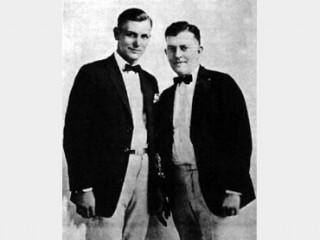
Carleton S. Coon biography
Date of birth : 1904-06-23
Date of death : 1981-06-03
Birthplace : Wakefield, Massachusetts
Nationality : American
Category : Science and Technology
Last modified : 2010-10-15
Credited as : Anthropologist, archaeologist, work on the origin of races
0 votes so far
Life
Coon was born in Wakefield, Massachusetts to a wealthy Yankee family. He developed an interest in prehistory, and decided to attend Phillips Academy in Andover. There he studied hieroglyphics, at the same time developing a proficiency in the ancient Greek language. He then went on to study Egyptology at Harvard University with George Andrew Reisner. However, like many other students, he was influenced toward the field of anthropology by Earnest Hooton, graduating magna cum laude in 1925.
Coon continued in Harvard, making the first of many trips to North Africa in 1925. There, he conducted fieldwork in the Rif area of Morocco, which was politically unsettled after a rebellion of the local populace against the Spanish. Coon earned his Ph.D. in 1928, and returned to Harvard as a lecturer and later a professor. He continued teaching at Harvard until 1948.
In 1939, he published a revision of William Z. Ripley's The Races of Europe (1899), which brought great success. Coon, like his mentor Hooton, wrote widely for a general audience, and his books were well accepted. He continued his field studies and published several novels and fictionalized accounts of those trips to North Africa, including The Riffian, Flesh of the Wild Ox, Measuring Ethiopia, and A North Africa Story: The Anthropologist as OSS Agent. This last book was an account of his work during World War II for the United States Office of Strategic Services, which involved espionage and the smuggling of arms to French resistance groups in German-occupied Morocco under the guise of anthropological fieldwork. Later, this activity was severely criticized by the scientific community in the name of scientific ethics.
In 1948 Coon left Harvard to take up a position as professor of snthropology at the University of Pennsylvania, which had an excellent museum attached to it. Throughout the 1950s Coon produced a series of academic papers, as well as many popular books for the general reader, like his most popular The Story of Man (1954). From 1948 to 1951 Coon did research in Iraq and Iran, and in Afghanistan in 1954.
Coon served as president of the American Association of Physical Anthropologists in 1961-1962. He conducted several more expeditions to Africa in the 1960s. Coon died in 1981 in Gloucester, Massachusetts.
Work
Coon's main hypothesis was that modern humans (Homo sapiens) arose through five separate lines from Homo erectus, in five separate geographical locations: "each subspecies, living in its own territory, passed a critical threshold from a more brutal to a more 'sapient' state."
oon attempted to use Darwin's theory of natural selection to explain the differing physical characteristics of various racial groups. He believed that different racial types struggled for domination over each other, in the same way that natural selection applies to other animal species. He wrote that "historically different strains in one population have showed differential survival values and often one has reemerged at the expense of others" (Coon 1939). Thus, Coon argued that, in their evolutionary development, different races reached the stage of Homo sapiens at different times, which explains why races achieved different levels of civilization.
Coon’s work was extremely controversial. His explanation of multilinear racial development and his emphasis on the white race led many commentators to criticize him for "scientific racism" common to the early twentieth century. His proponents, on the other hand, saw Coon’s work as an attempt to explain racial proliferation and development in scientific terms.
In 1962 he published his magnum opus, The Origin of Races. This book was widely denounced in anthropological circles, as physical anthropology had changed greatly since his time as an undergraduate at Harvard. Contemporary researchers such as Sherwood Washburn and Ashley Montagu were influenced by the modern synthesis in biology and population genetics, as well as a Boasian revolt against typological racial thinking. In this climate, the human species was regarded as a continuous "serial" progression of populations, rather than the five "parallel" genetically distinct races in Coon's account.
The 1960s were a controversial time for racial theories, and Coon's cousin, Carleton Putnam, suggested that Coon's work, among others, justified racial segregation. Coon stepped down as President of the American Association of Physical Anthropologists in protest after the association voted to censure Putnam's book Race and Reason: A Yankee view. Coon continued to write and defend his work until his death.
Legacy
Carleton Coon was a pioneer of physical anthropology. In his studies he advocated a holistic approach to anthropology, incorporating into his research elements of ethnography, social anthropology, physical anthropology, and archaeology.
He conducted numerous studies all around the world on the origins and variations of human racial types. His ideas generated controversy that has continued since his death.
















